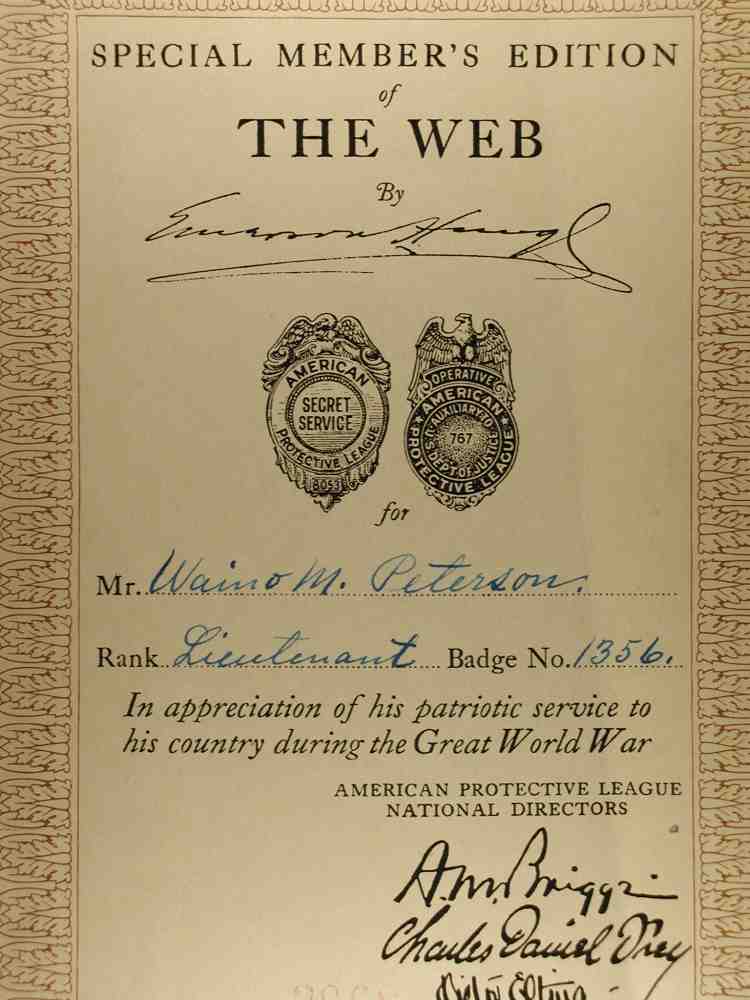 |
| The American Protective League Newsletter |
 |
| APL Special Members Certification |
The volunteer group was under a branch of the FBI, and was allowed because President Wilson and the Attorney General Gregory both supported it. It was legal to spy on your neighbors because of the Sedition act. This organization was huge by the end of WWI, with eighty to one hundred thousand members (mostly white American men in the beginning) represented throughout the country, in over six hundred cities and towns. Mostly in large cities where large alien activity was happening. They even had a newsletter, called The Spyglass! The "web" as the people in this society called themselves, believed their duty was to relieve overall fear of foreign spies, immigrants, and terrorists. The Web was infiltrated in every single aspect of daily life that you could imagine, including corporate business people, construction workers,newspaper writers, artists, any job you can think of, the important part is that extremely powerful people were involved with this.
 |
| APL to U.S. Food Administration: Carl A. Rink |
 |
| The American Protective League Badge |
The way I would describe it would be similar to the National Guard today. Except, instead of protecting our citizens physically, they are infiltrating terrorists and the equivalent of Al-Qaeda supporters. At the time of WWI, though, many critics of this group would have compared them to history repeaters, like the Sons of Liberty in the Civil War, the American Protective Association (which is similar, but failed ultimately), the Anti- Catholic Association, the Industrial Workers of the World, and because of their discrimination, some people have compared it to the Klu Klux Klan!
The APL only lasted for about a year, from March 1918, two weeks before America joined WWI, to February 1919, when it was said to be out of control, and not necessary any longer by the Attorney General, and commanded to be dissolved. The Web members badges and certifications were considered inane. Many members still had strong feelings about their dislike of suspicious citizens, but the activity surely died down. This was very interesting and I liked learning about it! However in my own opinion, I disagree with the people spying on anyone, other than the government looking at them.
Sources:
Primary Source: National Archives-OPL
primary source pictures and archives
AVL-Tulane Memorial Library- Special Collections,APL Records 1918, Louisiana Research Collection
basic information about the group
primary source pictures and archives
AVL-Tulane Memorial Library- Special Collections,APL Records 1918, Louisiana Research Collection
basic information about the group
APL: The American Protective League-History Magazine-J.G. Hammel
primary source about the group
primary source about the group
George Mason University. History News Network Civil Liberties, Joan Jenson
general information about the names and titles of people and also the league
general information about the names and titles of people and also the league
Biltmore Industries Archive
the size of the group
the size of the group
National Counter Intelligence Center-American Revolution-WWII
critics of the League
critics of the League
National Archives-records of the FBI
details about the group status in the government
details about the group status in the government
Kristen,
ReplyDeleteI am a historian researching the APL in New Orleans. Can you please tell me where I can find copies of "The Spyglass?" Thanks!
Brian Altobello 504-281-0359